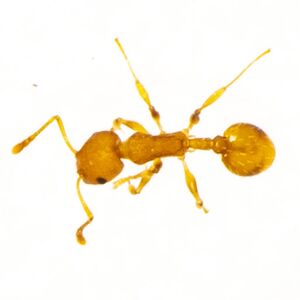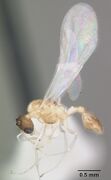Acorn ant: Difference between revisions
No edit summary |
|||
| Line 52: | Line 52: | ||
== Reproduction == | == Reproduction == | ||
Acorn ants are polygynous, meaning one colony can have multiple queens <ref name= "queen">Mackay, W. P. (2000). "A review of the New World ants of the subgenus Myrafant, (genus Leptothorax) ([[Hymenoptera]]: [[Formicidae]])". Sociobiology. 36: 265–444</ref>. Male ants will reproduce with the queens in a colony. Larvae can be found inside a nest all year-round. New colonies are formed by multiple queens | Acorn ants are polygynous, meaning one colony can have multiple queens <ref name= "queen">Mackay, W. P. (2000). "A review of the New World ants of the subgenus Myrafant, (genus Leptothorax) ([[Hymenoptera]]: [[Formicidae]])". Sociobiology. 36: 265–444</ref>. Male ants will reproduce with the queens in a colony. Larvae can be found inside a nest all year-round. New colonies are formed by pleometrosis (formed by multiple queens). Queens can also be adopted into an existing colony <ref name= "food"> Pratt, Stephen C. “Efficiency and Regulation of Recruitment During Colony Emigration by the Ant Temnothorax Curvispinosus.” Behavioral [[Ecology]] and Sociobiology, vol. 62, no. 8, 2008, pp. 1369–76, https://doi.org/10.1007/s00265-008-0565-9.</ref>. The queen will lay around a dozen eggs in a nest. The eggs hatch into larvae, which go through multiple molting stages as they grow. Eventually, larvae will metamorphose into a pupa and then grow into an adult ant. Queen and male ants have wings while the worker ants (female) do not <ref name= "cycle">Tate Holbrook. "Individual Life Cycle of Ants". ASU - Ask A Biologist. 17 Dec 2009. ASU - Ask A Biologist, Web. 4 May 2023. https://askabiologist.asu.edu/individual-life-cycle</ref>. | ||
[[File:Worker acorn ant.jpg|200px|thumb|Worker Acorn Ant <ref name= "multiple">“Species Temnothorax Curvispinosus.” BugGuide.Net, https://bugguide.net/node/view/328106/tree. </ref>]][[File:Male acorn ant.jpg|200px|thumb|Male Acorn Ant <ref name= "multiple">“Species Temnothorax Curvispinosus.” BugGuide.Net, https://bugguide.net/node/view/328106/tree. </ref>]][[File:Queen acorn ant.jpg|200px|thumb|Queen Acorn Ant <ref name= "multiple">“Species Temnothorax Curvispinosus.” BugGuide.Net, https://bugguide.net/node/view/328106/tree. </ref>]] | [[File:Worker acorn ant.jpg|200px|thumb|Worker Acorn Ant <ref name= "multiple">“Species Temnothorax Curvispinosus.” BugGuide.Net, https://bugguide.net/node/view/328106/tree. </ref>]][[File:Male acorn ant.jpg|200px|thumb|Male Acorn Ant <ref name= "multiple">“Species Temnothorax Curvispinosus.” BugGuide.Net, https://bugguide.net/node/view/328106/tree. </ref>]][[File:Queen acorn ant.jpg|200px|thumb|Queen Acorn Ant <ref name= "multiple">“Species Temnothorax Curvispinosus.” BugGuide.Net, https://bugguide.net/node/view/328106/tree. </ref>]] | ||
Revision as of 21:05, 28 February 2025

| |
| Kingdom: | Animalia |
|---|---|
| Phylum: | Arthropoda |
| Class: | Insecta |
| Order: | Hymenoptera |
| Family: | Formicidae |
| Subfamily: | Myrmicinae |
| Tribe: | Crematogastrini |
| Genus: | Temnothorax |
| Species: | Temnothorax curvispinosus |
| Image Source: Bug Guide [1] | |
Species Description
Temnothorax curvispinosus, or the acorn ant, is a well-studied species found in both rural and urban areas of the eastern United States. Their common name, "acorn ant," results from the fact that an entire colony (which typically contains between 50 and 200 worker ants, along with several queens) can live in hollowed-out nuts, such as acorns [2]. The acorn ant is amber to yellow in color, darkening with age, and it has 11 segmented antenna, along with a curved propodeal spine. The middle part of their body (mesosoma) is covered in rough ridges (rugae) [3]. They have been observed to act passively.
Habitat & Range

Starting along the eastern United States coast, acorn ants' range extends as far north as Maine, as far south as Florida, and as far west as Arizona. They can also be found in parts of Canada, including Ontario. They are likely to occupy temperate and subtropical northern forests [3].
Nesting Habits
In addition to hollowed-out nuts, acorn ant nests can be found in hollow stems, insect galls, puffballs, and pinecones. Nests may also be under rocks or in soil, usually at lower elevations. Acorn ants are polydomous (meaning they can inhabit several homes at the same time), and they can thus change where they reside after any disturbance in or around a nest [4]. In the summer, sub-colonies can form from a large colony and build a new nest near the main population's. During the winter, sub-colonies coalesce into one colony. But, about half of the colony is lost in the winter, as ants either die off or migrate to start or join a colony [5].
Reproduction
Acorn ants are polygynous, meaning one colony can have multiple queens [6]. Male ants will reproduce with the queens in a colony. Larvae can be found inside a nest all year-round. New colonies are formed by pleometrosis (formed by multiple queens). Queens can also be adopted into an existing colony [7]. The queen will lay around a dozen eggs in a nest. The eggs hatch into larvae, which go through multiple molting stages as they grow. Eventually, larvae will metamorphose into a pupa and then grow into an adult ant. Queen and male ants have wings while the worker ants (female) do not [8].



Diet
Acorn ants are generalists, but most commonly eat liquid sugars like honeydew from tree and plant leaves. These ants may also eat protein in the form of small insects, like spring tails and dipterans (flies). Acorn ants may also partake in foraging, which is usually done in tandem. Foraging in tandem means that one ant will recruit another, this recruited ant will recruit another, and the pattern continues. This strategy is particularly useful when there is a clumped food distribution. Foraging as a behavior is more common in the spring and summer [7].
Adaption
Acorn ants have shown sensitivity to high temperatures, and it has been found that colonies present in urban areas have better adapted to these temperatures. The development of cities has caused a rapid rise in environmental temperatures, especially with impervious surfaces. So, acorn ants have adapted to tolerate these rising temperatures. This finding was correlated with both faster rates of diurnal temperature rise in urban acorn ant nest sites and more rapid spatial changes in temperature across urban foraging areas [2].
References
- ↑ 1.0 1.1 1.2 1.3 1.4 “Species Temnothorax Curvispinosus.” BugGuide.Net, https://bugguide.net/node/view/328106/tree.
- ↑ 2.0 2.1 Diamond, Sarah E; Chick, Lacy D; Perez, Abe; Strickler, Stephanie A; Zhao, Crystal (14 June 2018). "Evolution of plasticity in the city: urban acorn ants can better tolerate more rapid increases in environmental temperature". Conservation Physiology. 6 (1): coy030. doi:10.1093/conphys/coy030. ISSN 2051-1434. PMC 6007456. PMID 29977563.
- ↑ 3.0 3.1 3.2 3.3 “Temnothorax curvispinosus.” AntWiki, https://www.antwiki.org/wiki/Temnothorax_curvispinosus
- ↑ Healey, Christiane I. M., and Stephen C. Pratt. “The Effect of Prior Experience on Nest Site Evaluation by the Ant Temnothorax Curvispinosus.” Animal Behaviour, vol. 76, no. 3, 2008, pp. 893–99, https://doi.org/10.1016/j.anbehav.2008.02.016.
- ↑ Pratt, S.C. Behavioral mechanisms of collective nest-site choice by the ant Temnothorax curvispinosus . Insect. Soc. 52, 383–392 (2005). https://doi.org/10.1007/s00040-005-0823-z
- ↑ Mackay, W. P. (2000). "A review of the New World ants of the subgenus Myrafant, (genus Leptothorax) (Hymenoptera: Formicidae)". Sociobiology. 36: 265–444
- ↑ 7.0 7.1 Pratt, Stephen C. “Efficiency and Regulation of Recruitment During Colony Emigration by the Ant Temnothorax Curvispinosus.” Behavioral Ecology and Sociobiology, vol. 62, no. 8, 2008, pp. 1369–76, https://doi.org/10.1007/s00265-008-0565-9.
- ↑ 8.0 8.1 Tate Holbrook. "Individual Life Cycle of Ants". ASU - Ask A Biologist. 17 Dec 2009. ASU - Ask A Biologist, Web. 4 May 2023. https://askabiologist.asu.edu/individual-life-cycle
- ↑ Bender, Eric (21 March 2022). "Urban evolution: How species adapt to survive in cities". Knowable Magazine. Annual Reviews. doi:10.1146/knowable-031822-1.
- ↑ “Acorn Ants and Allies (Genus Temnothorax).” INaturalist United Kingdom, https://uk.inaturalist.org/taxa/424607-Temnothorax#cite_note-Snelling_et_al_2014-5